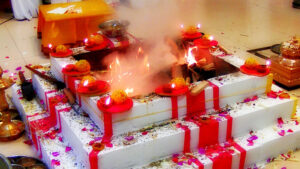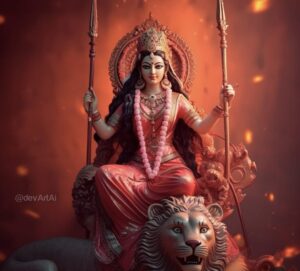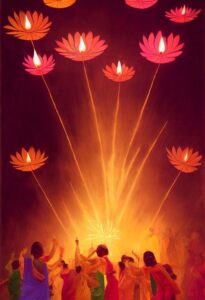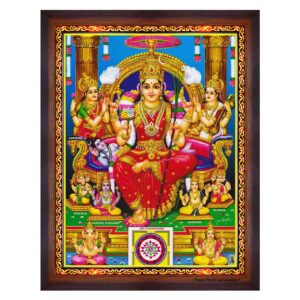In Hinduism, Gayatri Devi is revered as the personification of the Gayatri Mantra, one of the most powerful and sacred mantras in the Vedas. She is often depicted as a radiant goddess, riding a swan or seated on a lotus, symbolizing purity and enlightenment.

Title: The Birth of Gayatri Devi – A Divine Radiance
Once upon a time, in the celestial realm of gods and sages, there lived a mighty sage named Vishwamitra. His heart burned with a relentless ambition to achieve the exalted status of a Brahmarishi, a sage of the highest order. This tale begins with Vishwamitra’s thirst for power and the divine intervention that would transform him into a revered figure and birth Gayatri Devi, the goddess of supreme wisdom.
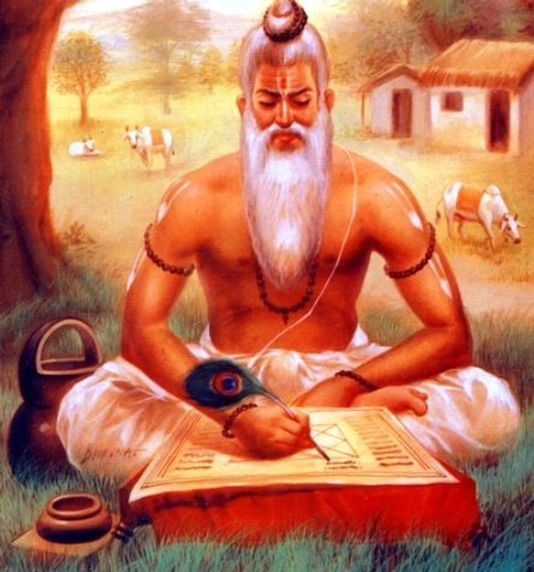
The Aspiring Sage: Vishwamitra’s Ambition
In the realms of sages and deities, Vishwamitra was known for his intellect and austere penance. But his heart was clouded with an intense desire to ascend to the status of a Brahmarishi, a title typically reserved for the most virtuous and wise sages. Determined to achieve this elevated rank, Vishwamitra embarked on a grand quest for spiritual attainment.
The Disruptive Yajna: The Demonic Yajna of Vishwamitra
In his pursuit of power, Vishwamitra decided to conduct a grand Yajna, a sacrificial ritual, despite the reservations of the gods themselves. Filled with arrogance and unbridled ambition, he hoped this Yajna would secure his position as a Brahmarishi, surpassing all known boundaries of spirituality. The consequences of this Yajna would send tremors through the cosmos which he was not aware of.

A Universe in Turmoil: Cosmic Imbalance Unleashed
As the Yajna commenced, it began to release an uncontrollable surge of energy and power. This raw cosmic force created an unprecedented disturbance in the universe, threatening to disrupt the balance that upheld the worlds. The gods grew alarmed, realizing that Vishwamitra’s quest for power was pushing the cosmos to the brink of chaos.
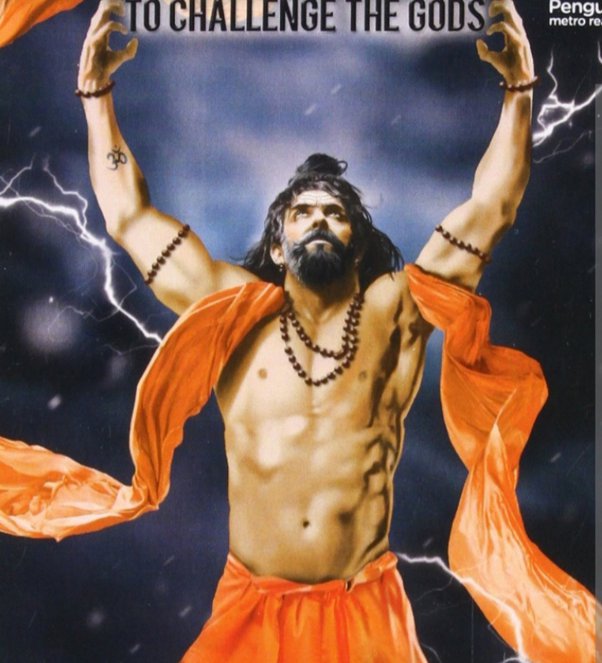
The Divine Intervention: Birth of Gayatri Devi
To avert the impending disaster and restore equilibrium, the gods called upon the Supreme Goddess. Out of their plea emerged Gayatri Devi, a radiant goddess of unparalleled wisdom and grace. She was the embodiment of the sacred Gayatri Mantra, a hymn that would later become one of the most potent sources of divine wisdom.

Vishwamitra’s Transformation: The Sage Redeemed
In a dramatic twist of fate, Gayatri Devi appeared before Vishwamitra, her divine presence calming the turbulent energies of his Yajna. The once-ambitious sage now found himself humbled in the radiance of Gayatri Devi. He realized the error of his ways and the profound wisdom that transcended earthly desires. Under her guidance, Vishwamitra shed his ego and arrogance, eventually achieving the coveted status of a Brahmarishi, not through power but through true enlightenment.
In this remarkable journey from ambition to humility, from cosmic imbalance to divine wisdom, the tale of Vishwamitra and Gayatri Devi serves as a timeless reminder that true power lies in wisdom and that even the most ambitious hearts can be transformed by the grace of the divine.
The Mythical Origin of Gayatri Devi
Lord Brahma, the creator of the universe, once embarked on a significant sacrificial ritual. To proceed, he required a consort and his desire was to have one immediately. In a moment of divine synchronicity, a beautiful maiden, who resided in the Himalayan realms near Mount Kailash and Lake Manasarovar, was brought to Brahma’s presence. He wed her instantly and made her his divine companion, allowing the grand ritual to commence. This maiden was, in fact, the divine manifestation of the sacred Gayatri Mantra itself, becoming Gayatri Devi.
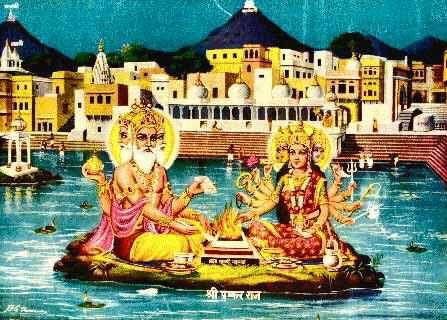
It’s not uncommon for people to mistakenly associate Goddess Gayatri with Savitri Devi and attribute her as the wife of Lord Brahma. However, the truth is that Goddess Gayatri is the divine consort of Lord Sadashiva, also known as Manomani or Mahagayatri. She is the embodiment of Brahmamayee Parashakti.
This magnificent goddess is depicted with ten hands, seated on a thousand-petal lotus. Her tantric form is Goddess Kamakhya, who shares similarities with her, as both are seated on a thousand-petal lotus and possess five heads with ten hands, adorned with three eyes on each face. In this aspect, Lord Shiva is revered as Vishwakarma, the creator of countless universes, illustrating the divine connection between the two.

Gayatri is often depicted with five faces, which symbolize the five chakras – Sristi (Creation), Stithi (Preservation), Pralay (Dissolution), Tirobhava (Concealment), and Anugraha (Grace). These faces also represent the five elements – water, air, sky, fire and earth.
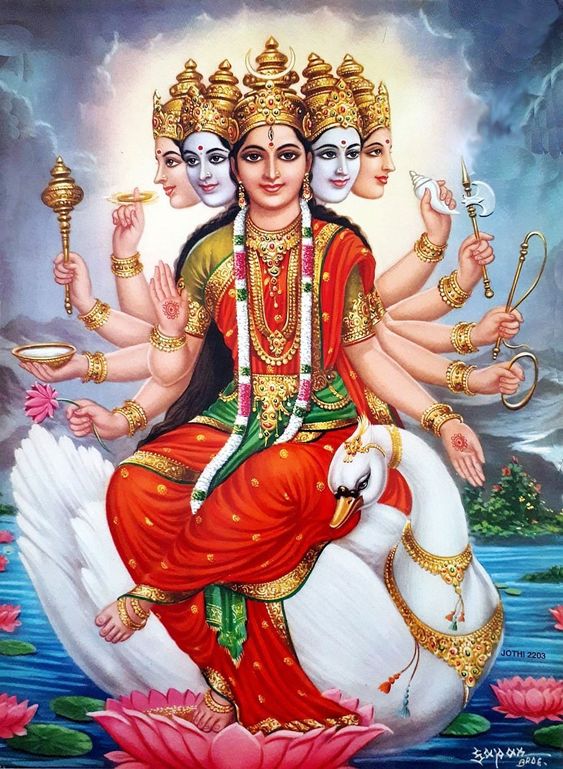
Five faces related to the directions:
- Savitri (East Face): This face represents the morning sun and is associated with the Gayatri Mantra, one of the most revered Vedic mantras. Savitri symbolizes the power of creation, illumination and the awakening of spiritual wisdom.
- Rakta (South Face): Rakta signifies the midday sun and is linked to the Ushnik Gayatri Mantra. This face embodies the energy of sustenance and nurturing, fostering growth and vitality.
- Saraswati (West Face): The face of Saraswati corresponds to the setting sun and is connected to the Anushtubh Gayatri Mantra. Saraswati represents knowledge, wisdom and the arts, bestowing the gift of eloquence and learning.
- Ila (North Face): Ila is the face associated with the cool light of the moon, connected to the Trishtubh Gayatri Mantra. This face symbolizes peace, tranquility and emotional balance.
- Kali (Central Face): Kali, the central face of Gayatri, signifies the inner self, the source of light and consciousness. It is associated with the Jagati Gayatri Mantra and represents the unmanifested cosmic energy.
These five faces of Gayatri embody the cycles of nature, time and the cosmic order. Worshipers invoke her through these faces to gain access to her multifaceted divine energy and blessings. The Gayatri Mantra, associated with Savitri, is the most widely chanted of these mantras and is believed to contain the essence of all Vedic knowledge.
The Legacy of Gayatri Devi: The Goddess of Supreme Wisdom
The birth of Gayatri Devi not only rescued the universe from chaos but also bestowed upon humanity the sacred Gayatri Mantra—a powerful invocation of wisdom, spiritual light and enlightenment. From that moment, Gayatri Devi became the beacon of supreme wisdom, guiding seekers and devotees on a path to inner illumination.
Gayatri Mantra:
The Profound Significance of the Gayatri Mantra
The Gayatri Mantra is not just any chant; it is a profound prayer, an embodiment of unwavering faith and devotion. This mantra is a direct invocation to the supreme universal spirit, beseeching its divine presence to enlighten the self and illuminate the intellect. Comprising 24 syllables, it carries profound meaning and a rhythmic resonance that is believed to possess immense potency. The Gayatri Mantra is a purifying force on Earth, showering sincere devotees with both material and spiritual blessings. It comes as no surprise that Gayatri Devi, the personification of this unique mantra, is revered as the mother of the Vedas and the universe.
The mantra is as follows:
“Om Bhur Bhuvah Svah Tat Savitur Varenyam Bhargo Devasya Dheemahi Dhiyo Yo Nah Prachodayat”
This mantra is usually recited during the daily Sandhyavandanam, a ritual performed by Hindus. It is believed to purify the mind and lead the seeker towards spiritual truth.
The Blessings of Worshiping Goddess Gayatri Devi and Chanting the Gayatri Mantra
Devotees who chant the Gayatri Mantra and worship Goddess Gayatri are blessed with sanctity in their endeavors. They receive the gifts of sharp intellect, radiance, enthusiasm and zeal, equipping them to shoulder responsibilities and complete them with success. The Goddess responds to their sincere prayers by removing obstacles, solving problems also bestowing strength, wealth, prosperity and success. Through these prayers, individuals purify themselves, paving the way for profound spiritual attainments.
Devotees of Gayatri Devi seek her blessings to illuminate their intellect and dispel ignorance, enabling them to walk the path of righteousness and self-realization. Gayatri Devi’s grace is invoked to awaken the inner light and dispel the darkness of ignorance.
Here’s a description of the symbolism of Goddess Gayatri’s appearance:
Symbolism of Goddess Gayatri’s Appearance
Goddess Gayatri is revered for her divine form and attire, each element rich in symbolism:
- Five Heads and Ten Eyes: Goddess Gayatri is often depicted with five heads and ten eyes. These multiple heads symbolize her divine presence in all directions, representing her ability to watch over and protect all living beings.
- Seated on a Lotus: She is seated on a red lotus, signifying purity, spirituality, and enlightenment. The lotus, while rooted in the mud, rises above the water, untouched and unstained, representing spiritual growth and the journey from materialism to spiritual awakening.
- Four Arms: In her four hands, she holds sacred items and weapons that symbolize different aspects of her divine powers. These may include a book, a lotus, a mala (prayer beads) and a water vessel. These items are emblematic of knowledge, purity, meditation and the bestowal of blessings.
- White Sari and Garland: Goddess Gayatri is typically adorned in a white sari, which represents purity, truth, and knowledge. She also wears a garland of white flowers, signifying purity and devotion.
- Swan: In her iconography, she may be accompanied by a swan. The swan is often associated with discernment, separating the good from the bad, and represents the ability to see the inner beauty and goodness in all things.
- Symbolic Colors: An orange saree worn by Goddess Gayatri can symbolize various attributes, including spirituality, knowledge and asceticism. Orange is often associated with the saffron color, which is significant in Hinduism and represents the renunciation of worldly desires, as well as spiritual awakening and the quest for knowledge.
- Bright Aura: The aura surrounding Goddess Gayatri often appears radiant, symbolizing the divine light of knowledge and wisdom that she imparts to her devotees.
- Universal Wisdom: Her depiction with multiple faces and hands suggests her all-encompassing wisdom and the ability to guide and protect her devotees from all sides.
Goddess Gayatri’s form embodies purity, enlightenment and the dissemination of knowledge. Her symbolism encourages seekers to embrace wisdom, purity and devotion while journeying towards spiritual awakening and self-realization.
Significance:
Mother of the Vedas: Gayatri Devi is sometimes called the “Mother of the Vedas” as her mantra is found in the Rigveda. The mantra itself is considered a condensed form of the wisdom contained in the Vedas.
Here are some more details about Gayatri Devi and her significance:
The Universal Prayer: The Gayatri Mantra is considered a universal prayer that transcends religious boundaries. It is recited not only by Hindus but also by people from various spiritual traditions around the world who seek wisdom and enlightenment. It is often referred to as the “Mother of all Mantras” and is a universal prayer for the welfare of all beings. It is chanted to promote peace, prosperity and harmony in the world.
Worship and Rituals: Devotees often perform daily rituals and meditations dedicated to Gayatri Devi. These practices are believed to purify the mind and intellect, aiding in spiritual evolution. “Katte Pongali” in Andhra Pradesh and occasionally referred to as “Khara Pongal” to differentiate it from the sweet variant, this dish stands as a beloved comfort food in South India. Crafted from a blend of moong dal and rice, it undergoes a tempering process with cumin, pepper, and ginger, all sizzled to perfection in generous amounts of ghee. This dish is offered to her as naivedya and later distributed to the devotees as prasadam.
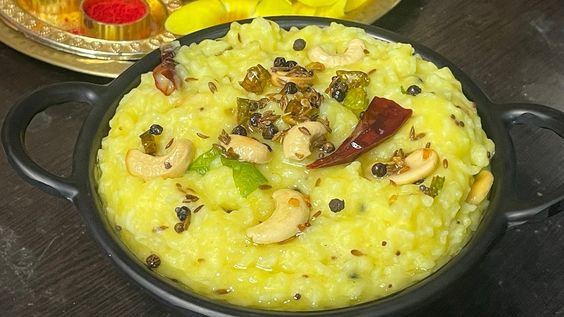
Meditation and Inner Transformation: Meditation on Goddess Gayatri’s form or the Gayatri Mantra is a path to inner transformation. It is a way to harmonize the mind, awaken the intellect and nurture divine qualities within the practitioner.
Illuminating the Five Elements: Goddess Gayatri’s five heads represent the five elements of nature – earth, water, fire, air and ether. Her worship is a way to acknowledge and harmonize our connection with these elements, fostering environmental consciousness and balance.
Guidance and Protection: Devotees seek the blessings of Goddess Gayatri for guidance, protection, and the removal of ignorance. Her divine grace is believed to lead individuals on the path of righteousness and spiritual awakening.
Universal Prayer: The Gayatri Mantra is often referred to as the “Mother of all Mantras” and is a universal prayer for the welfare of all beings. It is chanted to promote peace, prosperity and harmony in the world.
Inner and Outer Light: Gayatri Devi, like a radiant sun, is intrinsically linked to light. Think of her as the embodiment of the inner light of consciousness, a guiding star that beckons us to dispel the shadows of ignorance and embrace the path of self-realization. In the realm of symbolism, Gayatri Devi shares a deep connection with the Sun, representing the very essence of the Gayatri Mantra. This sacred hymn is a heartfelt address to the Sun deity, Savitar, who embodies the life-giving and illuminating qualities of the Sun. Imagine Gayatri Devi adorned with multiple heads and eyes, a divine representation of her all-encompassing nature and her profound connection to the radiant energy of the Sun. When you worship Gayatri Devi, you invite into your life the blessings of enlightenment, spiritual growth and the powerful energy of the Sun itself. Her divine essence is a radiant fusion of spiritual wisdom and the boundless energy of the Sun, guiding you on a journey towards inner illumination and self-discovery.
A Source of Knowledge: As the divine source of knowledge, Gayatri serves as a beacon for seekers of wisdom, guiding them in their quest for understanding the mysteries of life, the universe and the self.
The reverence for Gayatri Devi within Hindu culture reflects a profound thirst for knowledge, wisdom and spiritual evolution. She embodies the idea that wisdom can illuminate the path to spiritual enlightenment and overcome any challenge.
Author ,
Sivalenka Neeraja
